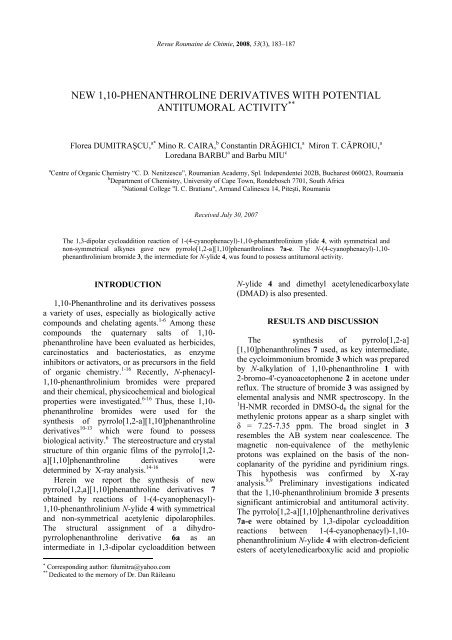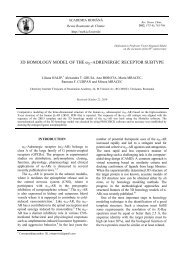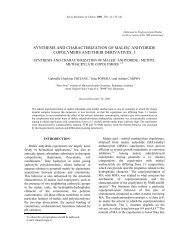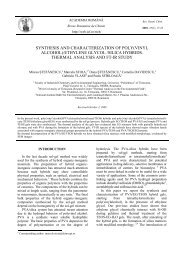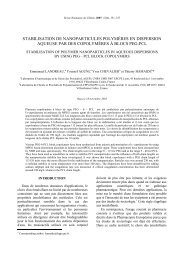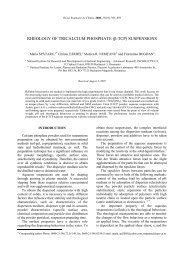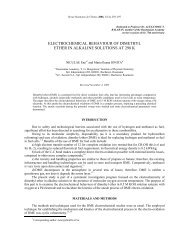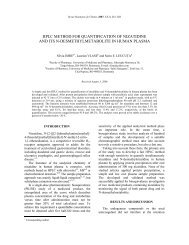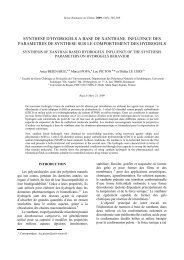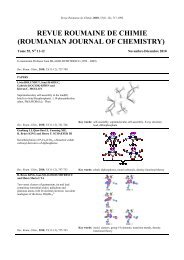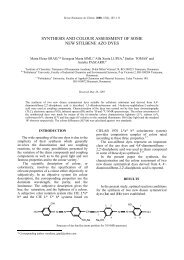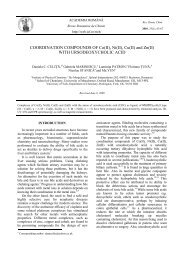new 1,10-phenanthroline derivatives with potential antitumoral activity
new 1,10-phenanthroline derivatives with potential antitumoral activity
new 1,10-phenanthroline derivatives with potential antitumoral activity
You also want an ePaper? Increase the reach of your titles
YUMPU automatically turns print PDFs into web optimized ePapers that Google loves.
Revue Roumaine de Chimie, 2008, 53(3), 183–187NEW 1,<strong>10</strong>-PHENANTHROLINE DERIVATIVES WITH POTENTIALANTITUMORAL ACTIVITY **Florea DUMITRAŞCU, a* Mino R. CAIRA, b Constantin DRĂGHICI, aLoredana BARBU a and Barbu MIU cMiron T. CĂPROIU, aa Centre of Organic Chemistry “C. D. Nenitzescu”, Roumanian Academy, Spl. Independentei 202B, Bucharest 060023, Roumaniab Department of Chemistry, University of Cape Town, Rondebosch 7701, South Africac National College "I. C. Bratianu", Armand Calinescu 14, Piteşti, RoumaniaReceived July 30, 2007The 1,3-dipolar cycloaddition reaction of 1-(4-cyanophenacyl)-1,<strong>10</strong>-phenanthrolinium ylide 4, <strong>with</strong> symmetrical andnon-symmetrical alkynes gave <strong>new</strong> pyrrolo[1,2-a][1,<strong>10</strong>]<strong>phenanthroline</strong>s 7a-e. The N-(4-cyanophenacyl)-1,<strong>10</strong>-phenanthrolinium bromide 3, the intermediate for N-ylide 4, was found to possess <strong>antitumoral</strong> <strong>activity</strong>.INTRODUCTION ∗1,<strong>10</strong>-Phenanthroline and its <strong>derivatives</strong> possessa variety of uses, especially as biologically activecompounds and chelating agents. 1-6 Among thesecompounds the quaternary salts of 1,<strong>10</strong>-<strong>phenanthroline</strong> have been evaluated as herbicides,carcinostatics and bacteriostatics, as enzymeinhibitors or activators, or as precursors in the fieldof organic chemistry. 1-16 Recently, N-phenacyl-1,<strong>10</strong>-phenanthrolinium bromides were preparedand their chemical, physicochemical and biologicalproperties were investigated. 6-16 Thus, these 1,<strong>10</strong>-<strong>phenanthroline</strong> bromides were used for thesynthesis of pyrrolo[1,2-a][1,<strong>10</strong>]<strong>phenanthroline</strong><strong>derivatives</strong> <strong>10</strong>-13 which were found to possessbiological <strong>activity</strong>. 6 The stereostructure and crystalstructure of thin organic films of the pyrrolo[1,2-a][1,<strong>10</strong>]<strong>phenanthroline</strong> <strong>derivatives</strong> weredetermined by X-ray analysis. 14-16Herein we report the synthesis of <strong>new</strong>pyrrolo[1,2,a][1,<strong>10</strong>]<strong>phenanthroline</strong> <strong>derivatives</strong> 7obtained by reactions of 1-(4-cyanophenacyl)-1,<strong>10</strong>-phenanthrolinium N-ylide 4 <strong>with</strong> symmetricaland non-symmetrical acetylenic dipolarophiles.The structural assignment of a dihydropyrrolo<strong>phenanthroline</strong>derivative 6a as anintermediate in 1,3-dipolar cycloaddition betweenN-ylide 4 and dimethyl acetylenedicarboxylate(DMAD) is also presented.RESULTS AND DISCUSSIONThe synthesis of pyrrolo[1,2-a][1,<strong>10</strong>]<strong>phenanthroline</strong>s 7 used, as key intermediate,the cycloimmonium bromide 3 which was preparedby N-alkylation of 1,<strong>10</strong>-<strong>phenanthroline</strong> 1 <strong>with</strong>2-bromo-4'-cyanoacetophenone 2 in acetone underreflux. The structure of bromide 3 was assigned byelemental analysis and NMR spectroscopy. In the1 H-NMR recorded in DMSO-d 6 the signal for themethylenic protons appear as a sharp singlet <strong>with</strong>δ = 7.25-7.35 ppm. The broad singlet in 3resembles the AB system near coalescence. Themagnetic non-equivalence of the methylenicprotons was explained on the basis of the noncoplanarityof the pyridine and pyridinium rings.This hypothesis was confirmed by X-rayanalysis. 8,9 Preliminary investigations indicatedthat the 1,<strong>10</strong>-phenanthrolinium bromide 3 presentssignificant antimicrobial and <strong>antitumoral</strong> <strong>activity</strong>.The pyrrolo[1,2-a][1,<strong>10</strong>]<strong>phenanthroline</strong> <strong>derivatives</strong>7a-e were obtained by 1,3-dipolar cycloadditionreactions between 1-(4-cyanophenacyl)-1,<strong>10</strong>-phenanthrolinium N-ylide 4 <strong>with</strong> electron-deficientesters of acetylenedicarboxylic acid and propiolic∗ Corresponding author: fdumitra@yahoo.com**Dedicated to the memory of Dr. Dan Răileanu
184 Florea Dumitraşcu et al.acid as dipolarophiles (Scheme 1). Theheteroaromatic N-ylide 4, being unstable, wasgenerated in situ by reaction between bromide 3and triethylamine. 1,3-Dipolar cycloadditionreactions of N-ylide 4 <strong>with</strong> dimethyl, diethyl ordiisopropyl acetylenedicarboxylate gavepyrrolo<strong>phenanthroline</strong> <strong>derivatives</strong> 7a-c in goodyields (79-87 %). The formation of compounds 7implies in the first step the 1,3-dipolarcycloaddition between 1,3-dipole 4 and acetylenicdipolarophiles giving the primary cycloadducts 5.Subsequently, the cycloadducts 5 undergo anisomerization reaction followed bydehydrogenation to the aromatic compounds 7a-c.NN - Et 3NNBr+ ArCOCH 2BrCHN2Cl 2N CH 2COArN++1 2 3 4H- COArH432ROOCC CCOORNNHCOArHCOORCOOREt 3N5678NHN111<strong>10</strong>9COArHCOORCOORNNCOArCOORCOOR5a-c 6a-c 7a-ca: R = Me; b: R = Et; c: R = iPr; Ar = 4-NCC 6 H 4Scheme 1Under similar reaction conditions, thecycloaddition between N-ylide 4 and esters ofpropiolic acid gave 9,<strong>10</strong>-disubstitutedpyrrolo<strong>phenanthroline</strong>s 7d,e (Scheme 2). On thebasis of H-NMR data it was established that thecycloaddition reaction is completely regioselective.NN+-BrCH 2COArHCEt 3NCCOORNNCOCN3 7d,ed: R = Me; e: R = Et; Ar = 4-NCC 6 H 4Scheme 2COORThe structures of compounds 7a-e wereassigned by elemental analysis and NMRspectroscopy. In the H-NMR spectra, recorded inCDCl 3 or CDCl 3 +TFA, the three protons of theterminal pyridine ring appear as a doublet ofdoublets (ABC system). It is interesting to notethat in CDCl 3 the value of the coupling constantbetween H-2 and H-3 is 4.3 Hz, whereas inCDCl 3 +TFA the same coupling constant has avalue of 6.2 Hz. Also, a strong deshielding in thecase of the three protons from the terminal pyridinering was observed. The difference between themagnitudes in CDCl 3 and CDCl 3 +TFA forchemical shifts and coupling constants could be
1,<strong>10</strong>-<strong>phenanthroline</strong> <strong>derivatives</strong> <strong>with</strong> <strong>potential</strong> <strong>antitumoral</strong> <strong>activity</strong> 185explained as being due to protonation of N-2 bytrifluoroacetic acid.Interestingly, in the H-NMR spectra ofcompounds 7b,e the methylenic protons in theester group appear as two ABX 3 systems. Also, themethyl groups in each isopropyl radical(compound 7c) were found to be non-equivalent inthe H-NMR spectrum, as well as in the C-NMRspectrum. As previously reported <strong>10</strong>,13,14 themagnetic non-equivalence of methylenic protonsand methyl groups represents good evidence forhelical distortion of the pyrrolo<strong>phenanthroline</strong>tetracyclic system.The C-NMR spectra for compounds 7 showedall the expected signals. The chemical shifts for thecarbon atoms were assigned from H/C correlationexperiments.When the cycloaddition reactions betweenN-ylide 4 and esters of acetylenenedicarboxylicacid were performed in the presence of an excessof triethylamine, the dihydro <strong>derivatives</strong> 6 wereisolated as sole product, or along <strong>with</strong> smallquantities of the corresponding aromatizedcompounds 7.The structures of dihydro <strong>derivatives</strong> 6b,c werededuced on the basis of NMR spectroscopy forrepresentative compound 6a. The positions for thetwo protons of the pyrrolinic ring were assigned onthe basis of their multiplicity, viz. two doublets<strong>with</strong> J = 4.5 Hz, as well as the high chemical shiftsof 7.58 ppm, attributed to H-11. The low value ofthe vicinal coupling constant between H-<strong>10</strong> and H-11 indicates a trans configuration. In the aromaticregion of compound 6a, the protons of the terminalpyridine ring show an ABC system due to H-2,H-3 and H-4, whereas the other protons from thepyrrolo<strong>phenanthroline</strong> moiety appeared as two ABsystems (J 5,6 = 8.5 Hz; J 7,8 = 9.6 Hz).Also, the position of the double bond in thepyrroline moiety was evident from the chemicalshifts of the three carbonyl groups. Thus, the largedifference between the two carbonyl ester groups(δ = 165.8 ppm and 173.5 ppm) show that they area attached to Csp 2 (δ = 165.8 ppm) and Csp 3(δ = 173.5 ppm) centres, respectively. Thedeshielding of the carbonyl group of the4-cyanobenzoyl moiety (δ = 188.6 ppm) by 6 ppmrelative to those of the corresponding aromaticcompounds 7a (δ = 182.5 ppm) is good evidencethat the radical is attached to a Csp 3 centre.The formation of dihydro<strong>derivatives</strong> 6 wasexplained by the regio- and stereoselectiveprototropic rearrangement of the primarycycloadducts 5 in the presence of an excess oftriethylamine. The dihydro derivative 6a could beeasily aromatized to the correspondingpyrrolo<strong>phenanthroline</strong> <strong>with</strong> the oxidant tetrakispyridinoCo(II)dichromate (TPCD). This reagentwas used for aromatization of cycloadductsobtained by reaction between heteroaromatic N-ylides and activated olefines. 17-19EXPERIMENTALMelting points were determined on a Boetius hot plate andare uncorrected. The NMR spectra were recorded on a VarianGemini 300 BB instrument, operating at 300 MHz for H and75 MHz for C. Supplementary evidence was given byHETCOR and COSY experiments.1-[2-(4-cyanophenyl)-2-oxoethyl]-1,<strong>10</strong>-phenanthroliniumbromide (3). 4 g (20 mmol) 1,<strong>10</strong>-Phenanthroline hydrate and5.5 g (22 mmol) 2-bromo-4'-cyanoacetophenone in 80 mLacetone were refluxed for 12 h. The precipitate was filtered bysuction and washed <strong>with</strong> water and acetone. Yield 76 %, m.p.245-7 °C (from ethanol). Anal. Calcd. for C 21 H 14 BrN 3 O: C62.39, H 3.49, Br 19.77, N <strong>10</strong>.39. Found: C 62.77, H 3.74, Br20.11, N <strong>10</strong>.60.1 H-NMR (300 MHz, DMSO-d 6 ) δ: 7.25-7.35 (bs, 2H,CH 2 ); 8.23 (d, 2H, J = 8.5 Hz, H-3', H-5'); 7.90 (dd, 1H,J = 8.2, 4.3 Hz, H-8); 8.36 (d, 2H, J = 8.5 Hz, H-2', H-6'); 8.41(dd, 1H, J = 4.3, 1.7 Hz, H-9); 8.48, 8.57 (2d, 1H, J = 8.9 Hz,H-5, H-6); 8.64 (dd, 1H, J = 8.2, 5.9 Hz, H-3); 8.78 (dd, 1H, J= 8.2, 1.7 Hz, H-7); 9.62 (dd, 1H, J = 8.2, 1.4 Hz, H-4); 9.69(dd, 1H, J = 5.9, 1.4 Hz, H-2).13 C-NMR (75 MHz, DMSO-d 6 ) δ: 69.4 (CH 2 ); 115.9,118.1 (CN, C-4'); 124.8 (C-3); 125.5 (C-8);; 127.0 (C-6);128.8 (C-2', C-6'); 130.7 (C-5); 131.5, 132.0(C-4a, C-6a);136.0, 137.6, 138.2 (C-<strong>10</strong>a, C-<strong>10</strong>b, C-1'); 133.3 (C-3', C-5');138.1 (C-7); 148.2 (C-4); 148.6 (C-9); 152.0 (C-2); 189.7(CO).Trans dimethyl 11-(4-cyanobenzoyl)-<strong>10</strong>,11-dihydropyrrolo[1,2-a][1,<strong>10</strong>]<strong>phenanthroline</strong> -9,<strong>10</strong>-dicarboxylate (6a).2.0 g (5 mmol) cycloimmonium bromide 3 and 5.5 mmolDMAD were suspended in 25 mL of methylene chloride. Themixture was cooled at 0 °C (ice bath), and 6 mmol oftriethylamine dissolved in 5 mL of methylene chloride werethen added under stirring, over 5 min. Stirring was continuedfor 20 min after which the reaction mixture was washed <strong>with</strong>water and the solvent removed at room temperature. Theresidue was triturated <strong>with</strong> ethanol, filtered and air dried. Theproduct was recrystallized from acetonitrile and red crystals<strong>with</strong> mp 230-3 °C were obtained; yield 91 %. Anal. Calcd.C 27 H 19 N 3 O 5 : C 69.76, H 4.11, N 9.03. Found: C 70.01, H4.23, N 9.18.1 H-NMR (300 MHz, CDCl 3 ) δ: 3.70, 3.85 (2s, 6H, 2Me);4.09 (d, 1H, J = 4.5 Hz, H-<strong>10</strong>); 7.22 (dd, 1H, J = 8.2, 4.2 Hz,H-3); 7.37, 7.47 (2d, 2H, J = 8.5 Hz, H-5, H-6); 7.44 (d, 1H,J = 9.6 Hz, H-7); 7.58 (d, 1H, J = 4.5 Hz, H-11); 7.88 (d, 1H,J = 9.6 Hz, H-8); 7.90 (d, 2H, J = 8.6 Hz, H-3', H-5'); 7.91(dd, 1H, J = 4.2, 1.8 Hz, H-2); 8.02 (1H, dd, J = 8.2, 1.8 Hz,H-4); 8.27 (d, 2H, J = 8.6 Hz, H-2', H-6').13 C-NMR (75 MHz, CDCl 3 ) δ: 49.6 (C-<strong>10</strong>); 50.4, 52.4(2MeO); 71.0 (C-11); 88.2 (C-9); 116.5, 117.9 (C-4', CN);119.7 (C-8); 121.0, 126.8 (C-5, C-6); 121.9 (C-3); 122.0,130.3, 135.2, 137.1, 137.3 (C-4a, C-6a, C-12a, C-12b, C-1');
186 Florea Dumitraşcu et al.129.6 (C-2', C-6'); 132.6 (C-3', C-5'); 136.6 (C-4); 146.1 (C-2); 155.0 (C-8a); 165.8 (9-COOMe); 173.5 (<strong>10</strong>-COOMe);188.6 (COAr).General procedure for synthesis of esters 7a-c. 2.0 g(5 mmol) phenanthrolinium salt 3 were suspended in 25 mL ofdichloromethane and 5.5 mmol of dimethyl (or diethyl,diisopropyl) acetylenedicarboxylate were then added. Undervigorous stirring 0.75 mL (5 mmol) of triethylamine(dissolved in 5 mL methylene chloride) were added dropwise.After 1 h the reaction mixture was washed twice <strong>with</strong> waterand the solvent evaporated. The residue was refluxed <strong>with</strong>stirring in ethanol for 1 h and the precipitate was isolated byfiltration.Dimethyl 11-(4-cyanobenzoyl)-pyrrolo[1,2-a][1,<strong>10</strong>]<strong>phenanthroline</strong>-9, <strong>10</strong>-dicarboxylate (7a).The product was recrystallized from DMF and yellow crystals<strong>with</strong> mp 329-331 °C were obtained; yield 87 %. Anal. Calcd.C 27 H 17 N 3 O 5 : C 69.97, H 3.70, N 9.07. Found: C 70.08, H 3.93,N 9.31.1 H-NMR (300 MHz, CDCl 3 +TFA) δ: 3.74, 3.95 (2s, 6H,2 MeO); 7.55 (d, 2H, J = 8.6 Hz, H-2', H-6'); 7.66 (d, 2H,J = 8.6 Hz, H-3', H-5'); 7.93 (d, 1H, d, 1H, J = 9.6 Hz, H-7);8.21 (dd, 1H, J = 8.1, 6.3 Hz, H-3); 8.28, 8.35 (2d, 2H, J =8.8 Hz, H-5, H-6); 8.57 (d, 1H, J = 9.6 Hz, H-8); 9.13 (dd, 1H,J = 8.1, 1.3 Hz, H-4); 9.36 (dd, 1H, J = 6.3, 1.3 Hz, H-2).13 C-NMR (75 MHz, CDCl 3 +TFA) δ: 52.4, 53.2 (2 MeO);95.1 (C-9); <strong>10</strong>9.6, 114.6, 116.9, 117.6, 122.4, 126.5, 127.0,128.5, 130.6 (C-4a, C-6a, C-8a, C-<strong>10</strong>, C-11, C-12a, C-12b, C-1', CN); 123.9 (C-7); 124.6 (C-3); 125.8 (C-8); 125.7, 130.3(C-5, C-6); 126.0 (C-2', C-6'); 133.0 (C-3', C-5'); 144.1 (C-2);145.6 (C-4'); 147.2 (C-4); 163.3, 165.0 (2COO); 182.5(COAr).Diethyl 11-(4-cyanobenzoyl)-pyrrolo[1,2-a][1,<strong>10</strong>]<strong>phenanthroline</strong>-9,<strong>10</strong>-dicarboxylate (7b). The product was recrystallized fromchloroform and yellow crystals <strong>with</strong> mp 292-4 °C wereobtained; yield 79 %. Anal. Calcd. C 29 H 21 N 3 O 5 : C 70.87,H 4.31, N 8.55 Found: C 71.08, H 3.93, N 9.31.1 H-NMR (300 MHz, CDCl 3 +TFA) δ: 1.20 (t, 3H,J = 7.1 Hz, <strong>10</strong>-Me); 1.40 (t, 3H, J = 7.1 Hz; 9-Me); 4.12-4.33(m, 2H, J = <strong>10</strong>.8, 7.1 Hz, <strong>10</strong>-OCH 2 ); 4.42 (q, 2H, J = 7.1 Hz,9-OCH 2 ); 7.56 (d, 2H, J = 8.6 Hz, H-2', H-6'); 7.67 (d, 2H,J = 8.6 Hz, H-3', H-5'); 7.95 (d, 1H, d, 1H, J = 9.6 Hz, H-7);8.22 (dd, 1H, J = 8.1, 6.3 Hz, H-3); 8.30, 8.37 (2d, 2H,J = 8.8 Hz, H-5, H-6); 8.59 (d, 1H, J = 9.6 Hz, H-8); 9.15 (dd,1H, J = 8.1, 1.3 Hz, H-4); 9.38 (dd, 1H, J = 6.3, 1.3 Hz, H-2).13 C-NMR (75 MHz, CDCl 3 +TFA) δ: 13.4, 13.9 (2Me);62.4, 63.8 (2CH 2 O); 94.2 (C-9); <strong>10</strong>8.9, 114.3, 116.4, 117.5,122.8, 126.3, 127.1, 128.5, 130.7 (C-4a, C-6a, C-8a, C-<strong>10</strong>, C-11, C-12a, C-12b, C-1', CN); 124.3 (C-7); 124.8 (C-3); 125.0(C-8); 125.9, 130.4 (C-5, C-6); 126.0 (C-2', C-6'); 133.2 (C-3',C-5'); 144.2 (C-2); 145.6 (C-4'); 147.6 (C-4); 163.4, 165.8(2COO); 182.6 (COAr).Diisopropyl 11-(4-cyanobenzoyl)-pyrrolo[1,2-a][1,<strong>10</strong>]<strong>phenanthroline</strong>-9, <strong>10</strong>-dicarboxylate (7c). The product was recrystallized fromacetonitrile and yellow crystals <strong>with</strong> mp 263-4 °C wereobtained; yield 81 %. Anal. Calcd. C 31 H 25 N 3 O 5 : C 71.67,H 4.85, N 8.09 Found: C 71.88, H 5.15, N 8.22.1 H-NMR (300 MHz, CDCl 3 ) δ: 0.94, 1.12 (2d, 6H, J = 6.3 Hz,<strong>10</strong>-CHMe 2 ); 1.37, 1.40 (2d, 6H, J = 6.2 Hz, 9-CHMe 2 ); 4.80(sep, 1H, J = 6.2 Hz, <strong>10</strong>-CHMe 2 ); 5.31 (sep, 1H, J = 6.2 Hz,9-CHMe 2 ); 7.35 (dd, 1H, J = 8.2, 4.3 Hz, H-3); 7.69 (d, 1H, d,1H, J = 9.5 Hz, H-7); 7.79 (d, 2H, J = 8.6 Hz, H-3', H-5');7.80, 7.87 (2d, 2H, J = 8.8 Hz, H-5, H-6); 7.91 (dd, 1H,J = 4.3, 1.7 Hz, H-2); 8.18 (dd, 1H, J = 8.2, 1.7 Hz, H-4); 8.23(d, 2H, J = 8.6 Hz, H-2', H-6'); 8.57 (d, 1H, J = 9.5 Hz, H-8).1 H- NMR (300 MHz, CDCl 3 +TFA) δ: 1.15, 1.29 (2d, 6H,J = 6.2 Hz, <strong>10</strong>-CHMe 2 ); 1.40, 1.41 (2d, 6H, J = 6.2 Hz,9-CHMe 2 ); 5.11 (sep, 1H, J = 6.2 Hz, <strong>10</strong>-CHMe 2 ); 5.29 (sep,1H, J = 6.2 Hz, 9-CHMe 2 ); 7.53 (d, 2H, J = 8.6 Hz, H-2',H-6'); 7.65 (d, 2H, J = 8.6 Hz, H-3', H-5'); 7.94 (d, 1H, d, 1H,J = 9.6 Hz, H-7); 8.22 (dd, 1H, J = 8.1, 6.3 Hz, H-3); 8.29,8.36 (2d, 2H, J = 8.8 Hz, H-5, H-6); 8.57 (d, 1H, J = 9.6 Hz,H-8); 9.14 (dd, 1H, J = 8.1, 1.3 Hz, H-4); 9.43 (dd, 1H,J = 6.3, 1.3 Hz, H-2).13 C-NMR (75 MHz, CDCl 3 ) δ: 21.1, 21.5, 21.9, 22.1(4Me); 68.1, 69.7 (CHMe 2 ); <strong>10</strong>4.8 (C-9); 115.3, 118.2 (C-1',CN); 120.4 (C-8); 122.3 (C-3); 125.4, 126.8 (C-5, C-6); 125.7(C-7); 125.8, 126.0, 127.7, 128.6 (C-4a, C-6a, C-8a, C-<strong>10</strong>,C-11); 130.3 (C-2', C-6'); 132.0 (C-3', C-5'); 136.3 (C-4);136.9, 137.1 (C-12a, C-12b); 145.1 (C-1'); 145.2 (C-2); 162.8,164.8 (2COO); 181.7 (COAr).13 C-NMR (75 MHz, CDCl 3 +TFA) δ: 21.1, 21.7 (4Me);70.6, 72.7 (CHMe 2 ); 94.5 (C-9); <strong>10</strong>9.4, 114.3, 116.6, 117.1,123.2, 126.4, 127.0, 128.5, 130.5 (C-4a, C-6a, C-8a, C-<strong>10</strong>, C-11, C-12a, C-12b, C-1', CN); 124.2 (C-7); 124.8 (C-3); 125.0(C-8); 125.9 (C-2', C-6'); 126.2, 130.4 (C-5, C-6); 133.3 (C-3',C-5'); 143.9 (C-2); 145.7 (C-4'); 147.6 (C-4); 162.9, 165.7(2COO); 182.6 (COAr).The procedure for synthesis of esters 7d,e. 2.0 g (5 mmol)Phenanthrolinium salt 3 were suspended in 25 mL ofdichloromethane and then 6 mmol of ethyl or isopropylpropiolate were added. Under vigorous stirring 0.7 mL(5 mmol) of triethylamine (dissolved in <strong>10</strong> mL of methylenechloride) were added dropwise. After 20 min the reactionmixture was washed <strong>with</strong> water and the solvent evaporated.The residue was purified by column chromatography onneutral Al 2O 3using CH 2Cl 2as eluent.Methyl 11-(4-cyanobenzoyl)-pyrrolo[1,2-a][1,<strong>10</strong>]<strong>phenanthroline</strong>-9- carboxylate (7d). The product was recrystallized fromnitromethane and yellow crystals <strong>with</strong> mp 246-7 °C wereobtained; yield 41 %. Anal. Calcd. for C 25 H 15 N 3 O 3 : C 74.07,H 3.73, N <strong>10</strong>.36. Found: C 74.23, H 4.11, N <strong>10</strong>.52.1 H-NMR (300 MHz, CDCl 3 ) δ: 3.94 (s, 3H, MeO); 7.38(dd, 1H, J = 8.2, 4.3 Hz, H-3); 7.55 (s,1H, H-<strong>10</strong>); 7.74 (d, 1H,J = 9.2 Hz, H-7); 7.82, 7.95 (2d, 1H, J = 8.6 Hz, H-5, H-6);7.85 (d, 2H, J = 8.6 Hz, H-3', H-5'); 8.19-8.23 (m, 2H, H-2,H-4); 8.31 (d, 2H, J = 8.6 Hz, H-2', H-6'); 8.59 (d, 1H, J =9.2 Hz, H-8).13 C-NMR (75 MHz, CDCl 3 ) δ: 51.3 (OMe); <strong>10</strong>6.0 (C-9);115.4, 118.2 (C-1', CN); 119.8 (C-8); 121.7 (C-<strong>10</strong>); 122.5(C-3); 125.4, 126.6 (C-5, C-6); 125.5, 127.8, 129.2, 131.6(C-4a, C-6a, C-8a, C-<strong>10</strong>); 126.2 (C-7); 130.5 (C-2', C-6');132.2 (C-3', C-5') 136.0 (C-4); 137.8, 138.9 (C-12a, C-12b);141.4 (C-4'); 146.0 (C-2); 164.8 (COO); 183.0 (COAr).Ethyl 11-(4-cyanobenzoyl)-pyrrolo[1,2-a][1,<strong>10</strong>]<strong>phenanthroline</strong>-9-carboxylate (7e). The product was recrystallized fromnitromethane and yellow crystals <strong>with</strong> mp 242-4 °C wereobtained; yield 37 %. Anal. Calcd. for C 26 H 17 N 3 O 3 : C 74.45,H 4.09, N <strong>10</strong>.02. Found: C 74.58, H 4.18, N <strong>10</strong>.21.1 H-NMR (300 MHz, CDCl 3 ) δ: 1.41 (t, 3H, J = 7.1 Hz;Me); 4.35-4.67 (m, 2H, J = <strong>10</strong>.4, 7.1 Hz, CH 2 ); 7.37 (dd, 1H,J = 8.2, 4.3 Hz, H-3); 7.53 (s,1H, H-<strong>10</strong>); 7.73 (d, 1H,J = 9.2 Hz, H-7); 7.82, 7.90 (2d, 1H, J = 8.6 Hz, H-5, H-6);7.85 (d, 2H, J = 8.6 Hz, H-3', H-5'); 8.19-8.23 (m, 2H, H-2,H-4); 8.26 (d, 2H, J = 8.6 Hz, H-2', H-6'); 8.59 (d, 1H, J =9.2 Hz, H-8).13 C-NMR (75 MHz, CDCl 3 ) δ: 14.6 (Me); 60.2 (CH 2 );<strong>10</strong>6.5 (C-9); 114.9, 118.4 (C-1', CN); 120.1 (C-8); 121.8(C-<strong>10</strong>); 122.7 (C-3); 125.3, 126.7 (C-5, C-6); 125.6, 127.8,
1,<strong>10</strong>-<strong>phenanthroline</strong> <strong>derivatives</strong> <strong>with</strong> <strong>potential</strong> <strong>antitumoral</strong> <strong>activity</strong> 187129.3, 131.6 (C-4a, C-6a, C-8a, C-<strong>10</strong>); 126.2 (C-7); 130.5(C-2', C-6'); 132.3 (C-3', C-5') 136.2 (C-4); 137.7, 138.9(C-12a, C-12b); 141.3 (C-4'); 146.0 (C-2); 164.4 (COO);182.8 (COAr).CONCLUSIONSSix <strong>new</strong> pyrrolo<strong>phenanthroline</strong> <strong>derivatives</strong> 6aand 7a-e were synthesized by 1,3-dipolarcycloaddition reactions between 1,<strong>10</strong>-phenanthrolinium N-ylide 4 and acetylenicdipolarophiles. The regioselectivity of thecycloaddition reaction was evidenced by use ofnon-symmetrical acetylenic dipolarophiles.The 1-[2-(4-cyanophenyl)-2-oxoethyl]-1,<strong>10</strong>-phenanthrolinium bromide 3 presents significantantimicrobial and <strong>antitumoral</strong> <strong>activity</strong>.F.D. thanks for financial support MEC, CEEX-Viasan program, no. 827/2005.MRC thanks UCT and the NRF (Pretoria) forresearch support.REFERENCES1. P. G. Sammes and G. Yahioglu, Chem. Soc. Rev., 1994,23, 327.2. L. A. Summers, Adv. Heterocycl. Chem., 1978, 22, 2.3. E. J. Gabbay, F. De Stefano and K.Sanford, Biochem.Biophys. Res. Commun., 1972, 46, 155.4. E. J. Gabbay, R. E.Scofield and C. S.Baxter, J. Am.Chem. Soc., 1973, 95, 7850.5. C. Paraschiv, S. Ferlay, M. W. Hosseini, N. Kyritsakas, J.-M.Planeix and M. Andruh, Rev. Roum. Chim., 2007, 52, <strong>10</strong>1.6. I. Druţă, R. Danac, M. Ungureanu, G. Grosu, G. Drochioiu,Ann. Pharm. Fr., 2002, 60, 348.7. F. Dumitraşcu, M. R. Caira, A. Bădoiu, C. Drăghici andL. Barbu, Rev. Roum. Chim., 2006, 51, 19.8. F. Dumitraşcu, M. R. Caira, C. Drăghici, M. T .Căproiu,A. Bădoiu, J. Chem. Crystallogr., 2004, 34, 577.9. M. R. Caira, F. Dumitraşcu, L. Barbu, D. Dumitrescu andB. Drăghici, Rev. Chim. (Bucharest), 2007, 58, 48.<strong>10</strong>. F. Dumitraşcu, C. I. Mitan, C. Drăghici, M. T. Căproiuand D. Răileanu, Tetrahedron Lett., 2001, 42, 8379.11. F. Dumitraşcu, C. I. Mitan, C. Drăghici and M. T. Căproiu,Rev. Roum. Chim., 2002, 47, 881.12. D. Ramona, A. Rotaru, G. Drochioiu and I. Druta,J. Heterocyclic Chem., 2003, 40, 283.13. F. Dumitraşcu, M. R Caira, C. Drăghici, M. T. Căproiuand A Bădoiu, Molecules, 2005, <strong>10</strong>, 321.14. F. Dumitraşcu, M. R Caira, C. Drăghici, M. T. Căproiu,L. Barbu and A. Bădoiu, J. Chem. Crystallogr., 2005, 35,361.15. L. Leontie, I. Druţă, R. Danac and G. I. Rusu, SyntheticMet., 2005, 155, 138.16. F. Dumitraşcu, M. R Caira, C. Drăghici and M. T. Căproiu,Anal. Sci. X, 2007, 23, x13.17. X. Wei, Y. Hu, T. Li and H. Hu, J. Chem. Soc. PerkinTrans I 1993, 2487.18. J. Zhou, Y. Hu and H. Hu, J. Heterocycl. Chem., 2000,37, 1165.19. B.Wang, J. Hu, X. Zhang, Y. Hu and H. Hu, J. Heterocycl.Chem., 2000, 37, 1533.
188 Florea Dumitraşcu et al.


